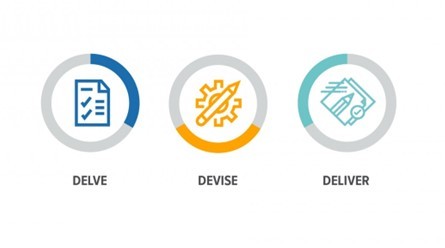It’s that time of year for scares and creepers, so let’s talk about all the ways to avoid them.
Let’s face it, some things are scarier than witches, ghosts, and goblins; they come in the form of quickly creeping scopes, suffocatingly tight deadlines and dehydrated budgets. The thought of facing such petrifying horrors can make any project manager shiver in their boots.
You might have heard of the terrible twos, but in our world, these are the terrible threes or better known as the Triple Constraints – Scope, Cost and Time.
Luckily, we’re not new to this game so we’ve trialled and tested many different potions and spells to find the perfect formula to avoid meeting these petrifying monsters.
So, as we head into the season of spooks and scares, we want to help shield you from joining the ghosts of failed projects past, and avoid letting these terrifying constraints constrain you and your project’s potential! With just the right amount of hanging garlic cloves, potions and spells, our team can keep your project under control.
Meet the enemy of cost and time – scope management.
But we’re confident, if we have the right planning and scope management in place, those ravenous demons will stay far, far away – no scope creep means no infested cost and time.
Let’s get armed…
The Creepy Crawly Project Scope
First things first, let’s recap.
What exactly is project scope?
Put relatively simply, the scope of a project is part of the project planning which sets out the parameters of all the work required to complete a project and the boundaries within which these activities sit. This includes a determination of the project goals, deliverables, tasks, costs and deadlines. As a project manager, the scope statement will be your fairy godmother and a scope management plan will tell you how to treat that fairy godmother.
Without properly controlling and managing the scope of your project throughout its lifecycle, the fear of meeting the creepy crawly scope terribly very real.
Now, we realise it can be easier and safer to opt for the fairy-tale fantasy this time of the year e.g. dressing up as a pretty princess or a handsome prince, but as M-CO’s Simon O’Rafferty suggests, it might be worth leaving the fantasy and delusions to the Halloween celebrations.
Simon criticises “optimism bias” and “illusion of certainty” for contributing to out-of-control projects and insists on erring on the side of caution during the planning stage of a project.
Let’s divulge…
Don’t be a Negative Necromancer or too much of a Positive Pumpkin – be a Sensible Simon
Falling into the trap of people/client pleasing can be a very dangerous game at the start of a new project. At M-CO we credit ourselves for our transparency. This means being realistic and considered when talking about the delivery of planned actions.
“Planning fallacy”, Simon says, is when plans and cost estimates stay unrealistically close to best-case scenarios. This type of careless sorcery can lead to underestimated cost and time as well as overestimated beneficial impact.
It’s not just the illusion of scary ghosts, it’s also the horror of the “illusion of certainty” explains Simon. A fan of biases, he says the “overconfidence bias means people can overestimate how much they understand about a project while underestimating how the role of chance, unplanned events and a lack of knowledge can impact on project delivery.”
The threat of scope creep gets even bigger when project managers hang too tightly onto that best-case scenario. Just like the pirates that will soon greet you at your front doors, begging for some tricks or treats, so too will the inevitability of drowning from the weight of that anchor you cling to, pleading for a dose of reality.
The anchoring effect – a cognitive bias which encourages people to rely too heavily on one piece of information when making decisions.
In this case, project planners and managers “risk anchoring decisions in best-case plans and their own limited experience rather than reviewing a range of possible outcomes” explains Simon.
Project management tip 101: Complete a risk assessment during the planning stage of your project and include risk management as part of your project’s ongoing activities to prevent and mitigate against delays, cost over-runs and unmet quality standards of your project.
Possibly a good dress-up choice, but certainly a bad management style – Positive Pumpkins increase risk, and risk underestimation leads you down the dark and dangerous path of scope creep.
Be realistic and considerate when agreeing to a project scope. Shut the gate to that scary road by being a Sensible Simon.
M-CO as ghost-busters scope-creep mitigators?
Introducing our special potion – Delve, Devise, Deliver
We understand how important it is to plan a project in detail and make sure every piece of the puzzle is there before you move on. Ensuring a tailored experience is catered to every one of our clients for every project, we continuously adapt our bespoke M-CO ‘Delve, Devise, Deliver’ service-delivery framework to provide a structure for robust work plans and reporting processes. LEAN principles are embedded within the framework to ensure our work is mapped against a clear timeline, with actions and outputs identified – delivering an effective foundation for scope-creep mitigation at the beginning of every project roadmap.

Our project delivery secret weapon is our Delve, Devise, Deliver methodology. However, this recipe is top secret. Everyone knows that the magic of potions is in their mystery; sharing them means the magic would be lost.
To protect M-CO from losing our magic, we can only divulge a sample of our special formula. We agree our ‘Delve’ phase is the perfect taster…
So, what happens at the Delve stage and how does it prevent scope creep?
Delve
At the outset of each project, we establish a project plan with the client, define key milestones and anticipated outputs, and agree on critical review points for reflection. We develop and agree on a clearly articulated, shared understanding of project scope, timelines, budget, our respective roles and deliverables. Our Delve phase commences by working closely with the client to refine the problem definition and better understand current challenges, issues, and opportunities along with the broader situational context. Upon completion of the Delve phase, a clear strategic direction for the project, a refined client brief and a project plan are established.
By employing a healthy project plan, our team lays the foundations necessary to prevent scope creep – a best-case scenario if you will (apologies, Sensible Simon).
The Wickedly Wonderful Work Breakdown Structure
A well-constructed project plan will provide a guide to the project owner, stakeholders and team members. The stakeholders and team members need to understand the objectives and deliverables of the project in order to make informed decisions on how to achieve these; this requires clarity on what is expected from everyone involved. A perfect example of a project management tool that supports this type of clarity is a Work Breakdown Structure.
Using a Work Breakdown Structure is really simple. As with any tool you’ll need to learn how it works best for you, but generally speaking, it’s very straightforward to put together – simply outline a list of tasks, dependencies and schedule for your project.
Part of the advantage of using a Work Breakdown that it limits the risk of those all-important ‘biases’ Simon speaks to.
He says, “a good Work Breakdown Structure provides clarity to clients in regard to the time allocated for actions and the sequence of phases, avoiding the optimism bias and the risks associated with it. Incorporating your version of a Delve phase at the beginning of a project can lead to a better understanding of the strategic and policy context for the project to help overcome anchoring and the overconfidence bias.”
A Work Breakdown Structure is the backbone of a project, and like any good skeleton, it holds everything together. It is a great tool for reducing the project size and complexity by breaking it down into manageable chunks. These chunks will take you from inception to completion and project closeout, with all the milestones and dependencies clearly flagged. It helps identify red flags in scope so that you can adjust accordingly before any increase in cost or time occurs. In other words, a Work Breakdown structure will be your knight in shining armour.
With the right planning, you can deter the spookiest of project management monsters, bring back to life doomed projects and revitalise cursed project managers. While we can’t be the protector of all possible project risks, ghosts and goblins, our solutions are designed to help you dispel the most petrifying of demons that lurk in the shadows of your projects. After all, it’s more than just a garlic problem!
Happy Halloween from Team M-CO!

